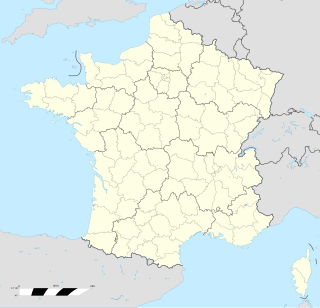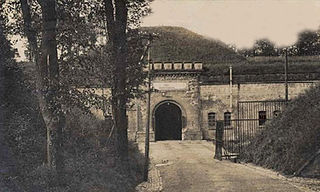Second World War
In early September 1944, at beginning of the Battle of Metz, and the German command integrated the defensive system set up around Metz. On September 2, 1944, Metz was declared one of the "Hitler fortresses", that must be defended to the last by German troops. [4] The next day, September 3, 1944, the troops of General Walther Krause took position on a line from Pagny-sur-Moselle to Mondelange, passing west of Metz by Chambley-Bussières, Mars-la-Tour, Jarny and Briey. After an initial withdrawal on 6 September 1944, German lines rested firmly on the Forts of Metz. On November 9, 1944, as a prelude to the Allied assault on Metz, as many as 1,299 heavy bombers, B-17s and B-24s, dumped hundreds of bombs on fortifications and strategic points in the combat zone of the United States IIIrd army. [5] Most bombers dropped their bombs without visibility from over 20,000 feet, so the military targets were often missed. At Metz the 689 loads of bombs destined to strike the seven forts, designated as priority targets, did nothing but collateral damage. [6]
The Fort Jeanne d'Arc was the last of the forts of Metz to surrender. Determined German resistance, bad weather and floods, inopportunity, and a general tendency to underestimate the firepower of the fortifications of Metz, helped slow the US offensive, giving the opportunity to the German Army to withdraw in good order to the Saarland. [7] The objective of the German staff, which was to stall US troops for the longest possible time at Metz before they could reach the Siegfried Line, was largely achieved.

The fortifications of Metz, a city in northeastern France, are extensive, due to the city's strategic position near the border of France and Germany. After the Franco-Prussian War of 1870, the area was annexed by the newly created German Empire in 1871 by the Treaty of Frankfurt and became a Reichsland. The German Army decided to build a fortress line from Mulhouse to Luxembourg to protect their new territories. The centerpiece of this line was the Moselstellung between Metz and Thionville, in Lorraine.

The Fort de Guentrange dominates Thionville in the Moselle department of France. It was built by Germany next to the town of the same name in the late 19th century after the annexation of the Moselle following the Franco-Prussian War. The Fort de Guentrange was part of the Moselstellung, a group of eleven fortresses surrounding Thionville and Metz to guard against the possibility of a French attack aimed at regaining Alsace and Lorraine, with construction taking place between 1899 and 1906. The fortification system incorporated new principles of defensive construction to deal with advances in artillery. Later forts, such as Guentrange, embodied innovative design concepts such as dispersal and concealment. The later forts were designed to support offensive operations, as an anchor for a pivoting move by German forces into France.

The Fort de Koenigsmacker is a fortification located to the northeast of Thionville in the Moselle department of France. It was built by Germany next to the town of the same name in the early 20th century after the annexation of the Moselle following the Franco-Prussian War. The Fort de Koenigsmacker was part of the Moselstellung, a group of eleven fortresses surrounding Thionville and Metz to guard against the possibility of a French attack aimed at regaining Alsace and Lorraine, with construction taking place between 1908 and 1914. The fortification system incorporated new principles of defensive construction to deal with advances in artillery. Later forts, such as Koenigsmacker, embodied innovative design concepts such as dispersal and concealment. These later forts were designed to support offensive operations, as an anchor for a pivoting move by German forces into France.

The Fort d'Illange is a fortification located to the south of Thionville in the Moselle department of France. It was built by Germany next to the town of Illange in the early 20th century after the annexation of the Moselle following the Franco-Prussian War. The Fort d'Illange was part of the Moselstellung, a group of eleven fortresses surrounding Thionville and Metz to guard against the possibility of a French attack aimed at regaining Alsace and Lorraine, with construction taking place between 1905 and 1911. The fortification system incorporated new principles of defensive construction to deal with advances in artillery. Later forts, such as Illange, embodied innovative design concepts such as dispersal and concealment. These later forts were designed to support offensive operations, as an anchor for a pivoting move by German forces into France.

Fort Jeanne d'Arc, also called Fortified Group Jeanne d'Arc, is a fortification located to the west of Metz in the Moselle department of France. It was built by Germany to the west of the town of Rozérieulles in the early 20th century as part of the third and final group of Metz fortifications. The fortification program was started after the German victory of the Franco-Prussian War, which resulted in the annexation of the provinces of Alsace and Lorraine from Germany to France. The Fort Jeanne d'Arc was part of the Moselstellung, a group of eleven fortresses surrounding Thionville and Metz to guard against the possibility of a French attack aimed at regaining Alsace and Lorraine, with construction taking place between 1899 and 1908. The fortification system incorporated new principles of defensive construction to deal with advances in artillery. Later forts, such as Jeanne d'Arc, embodied innovative design concepts such as dispersal and concealment. These later forts were designed to support offensive operations, as an anchor for a pivoting move by German forces into France.

The Fort de Plappeville, or Feste Alvensleben, is a military fortification located to the northwest of Metz in the commune of Plappeville. As part of the first ring of the fortifications of Metz, it is an early example of a Séré de Rivières system fort. While it did not see action during World War I, it was the scene of heavy fighting between American forces and German defenders at the end of the Battle of Metz, in 1944. After Second World War it became a training center for the French Air Force. Fort 'Alvensleben' has been abandoned since 1995.

The Fort de Saint-Julien, renamed Feste Manteuffel in German, is a military installation near Metz. It is part of the first fortified belt forts of Metz and had its baptism of fire in late 1944 in the Battle of Metz.

Fort Saint-Privat is a fortification near Metz. Part of the forts of Metz, it had its baptism of fire in late 1944 during the Battle of Metz.

The Feste von Zastrow, renamed Fort des Bordes by the French in 1919, is a military structure located in the district of Boric in Metz. It is part of the first fortified belt of the forts of Metz. Buried since the construction of the Eastern expressway in 1968, it is covered by a green space, although some remnants of the fort remain visible.

The Feste Hindersin renamed Gambetta fort by the French in 1919, is a military installation near Metz. It is part of the first fortified belt of forts of Metz and had its baptism of fire in late 1944, when Battle of Metz occurred.

The Feste Kameke, renamed Fort Déroulède by the French in 1919, is a military installation near Metz. It is part of the first fortified belt of forts of Metz and had its baptism of fire in late 1944, in the Battle of Metz.

The Fortifications of Saint-Quentin, or Feste Prinz Friedrich Karl form a fortification group in the Scy-Chazelles municipality located northwest of Metz on the Mont Saint-Quentin. Constituted by forts Diou and Girardin, the group is part of the first fortified belt of forts around Metz and had its baptism of fire in late 1944, when the Battle of Metz occurred.

The Feste Wagner, renamed Group Fortifications of Aisne by the French in 1919, is a fort of the second fortified belt of forts from Metz, in Moselle. This group fortification, built in the municipalities of Pournoy-la-Grasse and of Verny, controlled the valley of the Seille. It had its baptism of fire in late 1944, when the Battle of Metz occurred.

The Feste Leipzig, renamed Group Fortifications Francois-de-Guise after 1919 by the French, is a military structure located in the municipality of Châtel-Saint-Germain, close to Metz. It is part of the second fortified belt of forts of Metz and had its baptism of fire in late 1944, when the Battle of Metz occurred.

The Feste Lothringen, renamed Group Fortification Lorraine after 1919, is a military installation near Metz. It is part of the second fortified belt of forts of Metz and had its baptism of fire in late 1944, when the Battle of Metz occurred.

The Feste Mercy, renamed Feste Freiherr von der Goltz in 1911 and then The Group Fortification Marne in 1919, is a military installation near Metz, in the woods between Jury, Mercy and Ars-Laquenexy. It is part of the second fortified belt of forts of Metz and had its baptism of fire in late 1944, when the Battle of Metz occurred.

The Feste Haeseler, renamed Group Fortification Verdun after 1919, is a military installation near Metz. Constituted as forts Sommy and Saint-Blaise, the fortified group is part of the second fortified belt of forts of Metz. It had its baptism of fire in late 1944, when the Battle of Metz occurred.

The Feste Prinz Regent Luitpold, renamed Group Fortification Yser after 1919, is a military installation near Metz. It is part of the second fortified belt of forts of Metz and had its baptism of fire in late 1944, when the Battle of Metz occurred.

The Infanterie-Werk Belle-Croix, renamed Fort Lauvallière after 1919, is a military installation near Metz. It is part of the second fortified belt of forts of Metz.
The forts of Metz are two fortified belts around the city of Metz in Lorraine. Built according to the design and theory of Raymond Adolphe Séré de Rivières at the end of the Second Empire—and later Hans von Biehler while Metz was under German control—they earned the city the reputation of premier stronghold of the German reich. These fortifications were particularly thorough given the city's strategic position between France and Germany. The detached forts and fortified groups of the Metz area were spared in World War I, but showed their full defensive potential in the Battle of Metz at the end of World War II.







